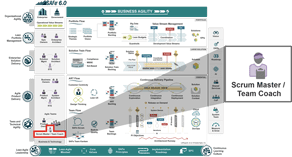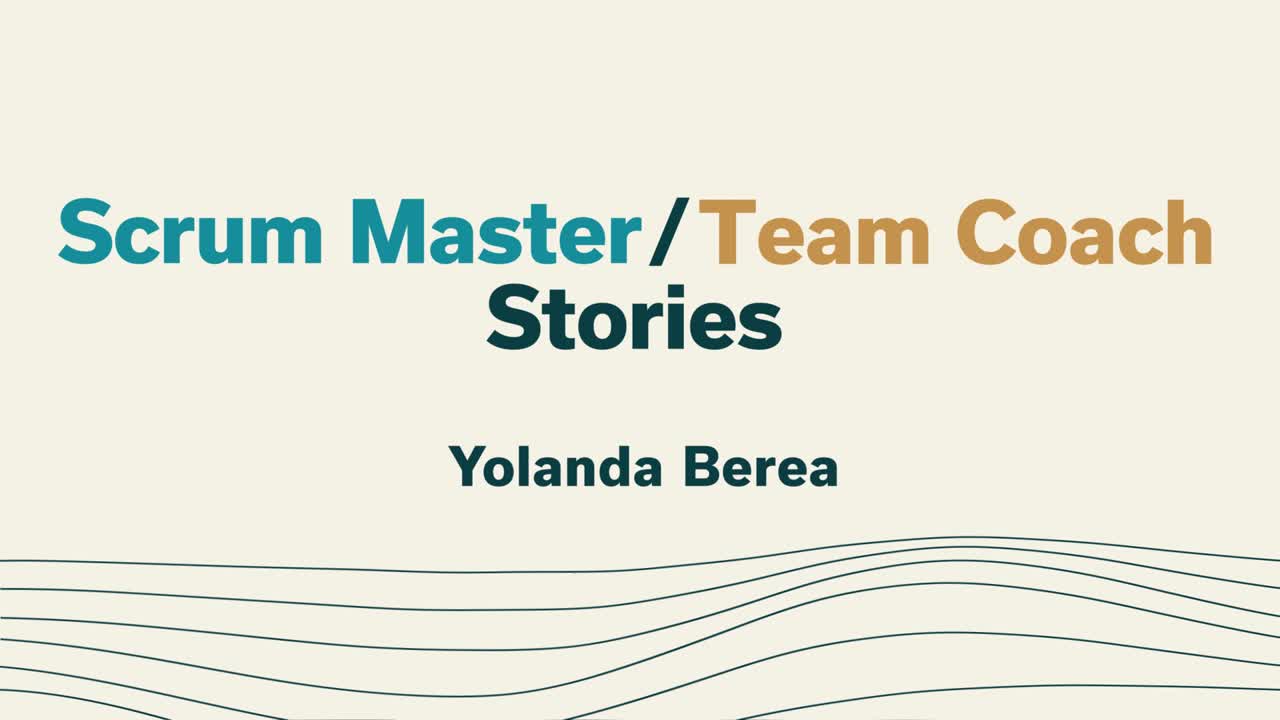
A Scrum Master is like an orchestra conductor, guiding a group of individuals to create something that no one of them could create alone.
—Mike Cohn, Paraphrased from Succeeding with Agile [1]
SAFeスクラムマスター / チームコーチ

注: SAFeスクラムについて詳しくは、スクラム関連の追加のフレームワーク記事をご覧ください。これには、SAFeスクラム、イテレーション、イテレーションプランニング、イテレーションゴール、イテレーションレビュー、そしてイテレーションレトロスペクティブが含まれています。
スクラムマスターのストーリー: ヨランダ
定義: SAFeスクラムマスター / チームコーチ (SM/TC) は、チームのイベントとプロセスをファシリテートするアジャイルチームのサーバントリーダーであり、チームとARTがバリューを提供するのを支援するコーチです。
彼らは、スクラム、作り込み品質、カンバン、およびSAFeについてチームを教育し、チームが合意されたアジャイルプロセスに沿うようにします。 また、阻害要因を取り除き、ハイパフォーマンスのチームダイナミクス、連続的なフロー、そしてたゆまぬ改善のための環境を育むのを助けます。
詳細
SAFeにおけるスクラムマスター / チームコーチ (SM/TC) は、チームがデリバリー目標を達成するのを支援します。 チームを自己組織と自己管理ができるようコーチングし、アジャイルリリーストレイン (ART) イベントの調整と参加を支援し、組織全体でのSAFeの効果を高めます。
SAFe SM/TCは、アジャイルチームの不可欠なメンバーであり、チーム全体のパフォーマンスに対する責任をチームと共有します。 SM/TCは、SAFeスクラムのプラクティスを採用するための特別なスキルを持ち、大きなギャップがないことを確認し、チームがどのようにプランを立て、実行し、レビューし、振り返るかを理解しています。 また、SM/TCは積極的にSAFeチームカンバンのチームをコーチングすることができ、各アジャイルチームがチームフローを達成するのを助けます。
SAFeスクラムマスター / チームコーチの特性
SM/TCの役割は、チームの目標達成を助ける責任を持つチームメンバーです。 その実現のために、SAFeスクラムとSAFeチームカンバンに対し、教えコーチングを行い、そしてSAFe原則とプラクティスをサポートします。 また、フローのボトルネックを特定し、排除することも支援します。
SM/TCは様々な経歴や役割を経験した人々が担っており、とても需要が高く必要とされています。 SM/TCは通常、人々のマネージャーではありませんが、アジャイルチームへの影響力のあるメンバーであり、以下の特性を持っている必要があります。
- 共感する - チームメンバーの信念や感情に対して真の理解と関心を示すことで、チームをサポートします。 その結果、チームは他者との関係を構築する可能性が高くなり、コラボレーションとパフォーマンスのレベルが高まる可能性があります。 共感は信頼の重要な要素であり、人々がコーチングを受け入れ、納得するためには不可欠です。
- コンフリクトナビゲーターである - チームメンバーが、対人関係におけるコンフリクト(対立や衝突)を解消し、問題解決と意思決定を支援します。 アジャイルコーチであるリサ アトキンスは著書で、「対立の調整は、私たちの新たなマインドセットであり、それはチームを対立から建設的な意見の不一致へと移行させ、ハイパフォーマンスへと飛躍させるための助けとなります」と述べています。[2]
- サーバントリーダーである - 権威を行使するのではなく、諭す。 サーバントリーダーとして、SM/TCはチームメンバーとサービスを提供する人々のニーズに焦点を当て、組織のバリュー、原則、ビジネスのオブジェクティブと一致した結果を達成することを目指します。[3] 彼らは、状況やチームのパフォーマンスに対する説明責任に応じて、チームとどのように協力するかを選択することができます。 SM/TCは、責任を達成するための選択肢を持つべきです。 例えば、イベントに関しては、「すべてのチームイベントが行われ積極的、生産的で、タイムボックス内に保たれるようにする」というような責任です。 SM/TCはイベントをファシリテートすることも、チームに自己管理させて自分たちのイベントをファシリテートさせることもできます。 イベントや会議の進行役を持ちまわりで行うことは、チームの成長と自己管理能力にとって不可欠です。
- メンターである - チームメンバーの個人的な開発を支援し、彼らが継続的な学習のマインドセットを身につけるのを助けます。 SM/TCは、チームが答えを与えられるのではなく、自立して問題のソリューションを見つけるように導きます。
- 透明性を持つ - 透明性はSAFeのコアバリューであり、経験主義の柱の一つです。 SM/TCはフィードバックに対してオープンであり、他者からの透明性を大切にします。 SM/TCは、チームが成果物が検査されていることを確認し、予想される結果と実際の結果との間の重要な違いを特定し、アンチパターンを検出することを確かなものとすることで、チームが透明性を示すのを支援します。
- コーチングする – SM/TCは、スクラムを超えた方法、例えばSAFe、カンバン、フロー、作り込み品質などについて理解し、チームに教育を提供します。 彼らはしばしば1つ以上の技術的およびビジネスの分野で高度なトレーニングを受け、経験を持っています。
責任
SM/TCは、図1で示されているように、役割を果たす上で多くの重要な責任を果たします。 これらの各責任は、以下のセクションで説明されています。
PIプランニングをファシリテートする
SM/TCはPIプランニングにおいて重要な役割を果たします。 他のSM/TCおよびリリーストレインエンジニア(RTE)と協力し、PIプランニング中に積極的にチームと共に働きます。 効果的なSM/TCは、イベントを成功させるにあたって重要であり、通常、PIプランニングをファシリテートするために以下の活動を行います。
- PIプランニングの準備 - イベントの前に、SM/TCは、プロダクトマネージャー、ビジネスオーナー、および他のステークホルダーから、図2に示すように、チームが今後のフィーチャーについて確実に説明を受けるようにします。 アジャイルチームとプロダクトオーナーが、今後のPIでチームが達成する必要があるローカルなストーリー、メンテナンス、欠陥、技術的な負債、およびその他の仕事を特定するのを支援します。
- ドラフトPIプランの作成 - SM/TCは、チームがPIのイテレーションのためのドラフトPIプラン、そしてドラフトPIオブジェクティブを作成し、ARTのリスクと問題を特定するのをファシリテートします。 SM/TCはまた、チームがデジタルまたは物理的にプランニングを行う場所の設定を支援し、透明性とコラボレーションを生み出す視覚的なラジエーターを提供します。 チームが自身のキャパシティを決定し、その制約内に保つのを助けます。
- 他のチームとの調整 - SM/TCは、イベント中の協力とコミュニケーションを確保するのを支援します。 PIプランニング中では、通常、関連分野の専門家(SME)とARTステークホルダーを確保し、どのようにフィーチャー開発にて協力し依存関係を解決するかを決定するために、他チームを含めたコミュニケーションを促進します。
- チームのPIオブジェクティブの作成 – SM/TCは、チームが次のPIで達成しようとしていること、つまりチームのPIオブジェクティブを作成するのを支援します。 ドラフトプランレビューの前にオブジェクティブが記述され、コミット済みのオブジェクティブとアンコミットオブジェクティブが適切に混在していることを確認します。
- 最終プランとビジネスバリューのレビュー – 最終レビューの前に、SM/TCはPIオブジェクティブがSMART(Specific, Measurable, Achievable, Realistic and Time-bound)(具体的、測定可能、達成可能、現実的および期限付き)であり、誰もが理解できるように書かれていることを確認するのを支援します。 SM/TCは、通常ビジネスバリューの割り当て中に、ビジネスオーナーとチームのコラボレーションをファシリテートします。
イテレーション実行のサポート
SM/TCは、イテレーション中にアジャイルチームをサポートし、イテレーションゴールとPIオブジェクティブの達成可能性を高めます。 例えば、以下の活動を行います。
- チームのイベントをファシリテートする – アジャイルチームは、取り組みを調整し同期をとるためにケイデンスベースのイベントを使用します。 スクラムとチームカンバンは、やや異なる方法で運用されますが、すべてのチームはプランを立て、同期し、レビューし、自分たちの仕事を検討し、レトロスペクティブを開催する必要があります。 図3に、アジャイルチームが通常イテレーション中に行うイベント(またはアクティビティ)を示します。
- ARTのケイデンス内で仕事する - SM/TCは、アジャイルリリーストレイン(ART)による開発のケイデンスと同期においてスクラムまたはカンバンを適用するのを支援します。 このケイデンスと同期が、ベクトルを合わせ、依存関係を管理し、リリースオンデマンド、そして迅速な統合学習サイクルを促進します。(SAFe原則#4)
- POとの協力 - プロダクトオーナー (PO)は、チームの仕事から生じるソリューションのバリューを最大化する責任があるため、SM/TCの役割の重要な側面はPOをサポートすることです。 これを、以下の方法で行います。
- チームが顧客中心の考え方とデザイン思考のツールとテクニックを理解、適用して、正しい時に正しいものを構築するのを助けます。
- チームが明確で簡潔なチームバックログ項目の必要性を理解し、それらが各作業項目の種類に対するARTのキャパシティ配分に合っていることを確認します。
- チームが経験に基づくプランニングと開発を適用し、小さなインクリメントで機能するソリューションの観察と実験に基づいて進捗状況を評価することを支援します。
- 要求がある場合もしくは必要に応じてステークホルダーのコラボレーションを促進します。
フローの改善
SM/TCは、チームのワークフローを大幅に改善し、ボトルネック、遅延、ムダを排除することができます。 このコーチングには、しばしば以下の活動が含まれます。
- チームカンバンボードを設定する – SAFeチームは、自身の仕事を視覚化し、フローを強化するためにカンバンボードを使用します。 特定のアジャイルチームのニーズに合わせて効果的なカンバンシステムを実装することは、実行される仕事の種類(マーケティング、ソフトウェア開発、ハードウェア開発)、チームメンバーのスキル、そして彼らのARTにおける役割に基づいています。 カンバンシステムの作成は、経験豊富なコーチであるSM/TCのガイドとファシリテーションのもと、アジャイルチーム全体を巻き込んで行うのが最善です。 SAFeの詳細ガイダンス記事、SAFeでのカンバンの適用は、カンバンシステムの設立方法と、SAFe内でのカンバンシステムの接続方法について説明しています。 図4はチームカンバンボードの例を示します。
- フローを測定し、最適化する – SM/TCは、チームがパフォーマンスをアセスし、全体的に改善するためのメトリクスを設定するのを支援します。 「フロー」、「コンピテンシー」、そして「成果」の具体的な測定は、メジャー&グローで説明されています。 フローメトリクスは、SM/TCとチームがプロセスを反復的に進化させ、チームのニーズに継続的に適応するのを助けます。 初期のプロセスとWIP制限を定義し、しばらく実行するとボトルネックが見えるようになります。 見えない場合、チームはプロセスを改善するか、WIP制限をさらに減らして、ワークフローの状態が過負荷または無負荷であることが明らかになるまで行います。 フローの最適化のための他のコーチングを行う機会としては、ステップの統合や分割、そしてバッファー、スイムレーンおよびサービスクラスの追加、またはワークフローステートの再定義があります。
- 品質を作り込む – アジャイルチームは、高品質なビジネスケイパビリティを迅速に開発しリリースするため、迅速なフローベースのシステムにて運用します。 SM/TCは、迅速で信頼性のある実行を可能にする作り込み品質のプラクティスをコーチングすることで、必要かつ頻繁な変更が効率的、効果的に行われるようにします。
ハイパフォーマンスチームを構築する
高いバリューのあるインクリメントを機能するソリューションとして作り出すためには、健全なアジャイルチームを作ることが不可欠です。 幸いなことに、ハイパフォーマンスチームのための多くの要素は、SAFeのデザインとしてすでに組み込まれています。 例えば、SAFeのアジャイルチームは小さく、機能横断的で、自己組織化されています。 彼らには、チームとARTのオブジェクティブを達成するために必要な仕事を定義し、実行する権限を与えられています。 全員が一致して、すべてのインクリメントが共有可能でスケーラブルな完了の定義を満たすべきであることに同意します。 SM/TCは、ハイパフォーマンスチームを構築する上で重要な役割を果たし、以下のような活動を通してこれを達成します。
- アジャイルチームの特性を育成し、支援する – チームごとに異なりますが、ハイパフォーマンスチームには共有する共通の特性があります。 SM/TCは、以下のアジャイルチームの属性を支援し育成する責任があります。
- 自己マネジメントを行いオーナーシップと説明責任を取り込む
- 足並みが揃い協調性がある
- 成功は明確なゴールと目的に焦点を当てる
- 他者への仕事のインパクトを理解する影響力のある意思決定者
- オープンで透明なコミュニケーションと信頼でオペレーションする
- 多様性を大切にし、健全な対立に価値を見出す
- 効果的で迅速なフィードバックを提供する
- 高度に関与し、業務とチームとの関係を楽しむ
- ハイパフォーマンスチームのダイナミクスを奨励する – SM/TCは、ハイパフォーマンスのチームダイナミクス、連続的なフロー、そしてたゆまぬ改善のための環境を育てます。 SM/TCは、チームをガイドし、相互尊重の雰囲気を作り出し、対人間の個人的な対立を解決し、成長の機会を見つけるのを助けます。 彼らはチームが各イテレーションで高いバリューのインクリメントを生み出すことに「集中」するのを支援します。
- より効果的なスクラムマスター / チームコーチになる - すべてのサーバントリーダーは、結果を提供する他の人々の開発を促進することから成長が生じることを知っています。 SM/TCは、チームとより大きな組織に奉仕します。 SM/TCは、ステークホルダーや非アジャイルチームに対してアジャイルチームとの効果的な交流をコーチングし、 SM/TCの実践コミュニティに参加し、組織のSAFeプラクティスコンサルタントをサポートすることで、企業全体でのSAFeの採用を支援します。
- リーンアジャイルリーダーとしての役割を果たす – SM/TCもまたSAFeの採用を推進します。 SM/TCは模範となり、リーンアジャイルマインドセットとSAFeリーンアジャイル原則を取り入れてリードします。 これらの概念を自分たちの責任に統合し、他の人が追随する役割モデルとして行動します。
- チーム内のコラボレーションを促進する - SM/TCの役割は、より効果的で結束力のあるチームを育成し、より良いビジネスの成果、ソリューション、およびプロダクトを可能にします。 SM/TCは、自分たちが知っていることや、うまくいったことに基づいて、観察結果、フィードバック、ガイド、アドバイスを提供します。
- 効果的な質問でコーチングする - しかし、SM/TCはすべての答えを持っているわけではありません。 そこで、何が本質的かを明らかにするために「効果的な質問」を行うことにより、他の人々が自分たちの知識と専門知識を引き出せるように導くことができます。 幾つかの「効果的な質問」の例を下記に挙げます。
- この質問に至った理由は何ですか?
- 他にどのような可能性や選択肢が存在しますか?
- 見落としていることは何ですか?
- より深い理解に到達するためには、何をすべきですか?
- 成功が保証されていたら、どのようなアクションを取りますか?
「効果的な質問」をすることで、SM/TCはチームがパフォーマンスを改善させ、問題をより自立して解決し、より良い決定を下し、新しいスキルを学び、目標をより良く達成するように助けます。
- チームの対立を解決する - チームワークは競争上の究極の優位性を持ちます。 しかし、多くのチームが機能不全になっていると、コンサルタントであり『The Five Dysfunctions of a Team (あなたのチームは機能してますか)』の著者であるパトリック レンシオーニが指摘しています。そこでレンシオーニは、信頼の不在が他の4つの機能不全につながると指摘しています。[4] SM/TCは、図5に示すようにSAFeのプラクティスと共に、これらの5つの機能不全に対処します。
- チームのスキルセットを開発する - SM/TCは、チームメンバーとその部門マネージャーと協力して、彼らがT字型のスキルを習得するのを支援します。 「T字型」のスキルを持つメンバーは、多くの領域で広範で一般的な専門知識を持ち、これらの分野の一つにおける専門家です。 SM/TCは、チームメンバーがスキルの拡張のために他のメンバーとペアを組んだり、別の分野やビジネス分野でタスクを引き受けたり、トレーニングコースに参加したり、継続的な学習を行うため書籍を読むことを奨励します。
ARTパフォーマンスの改善
SM/TCは、以下の活動を通じて、アジャイルチームが全体的なARTパフォーマンスを改善していくのを支援します。
- チーム間のコラボレーションをファシリテートする - チーム間のコラボレーションは、ハイパフォーマンスチームの特徴です。 アジャイルチームは、ホールプロダクトのソリューションを市場に投入するために、部門間で協力します。 SAFe SM/TCは、チーム間のコラボレーションが成功する環境を育て、チームが一緒に働く機会を提供するプラクティスによって支えられています。例えば下記があります。
- ART PIオブジェクティブ、ビジョン、戦略テーマへのベクトルを合わせ、そしてPIプランニング中に依存関係をARTボードを使用して対処する
- チームを代表して、コーチシンク、POシンク、そしてARTシンクに参加する
- 関連するチームメンバーと一緒に他のチームのイベントやデモに参加する
- ARTのシステムデモとインスペクト&アダプトイベントに参加する
チーム内やチーム間で働くことの重要なベネフィットの一つは、同僚がお互いから学ぶことです。 アジャイルチームでは、新しいスキルを学ぶことが、全員を組織にとってより価値ある存在にし、お互いの仕事をサポートするための準備を整えます。 それはまた(限られた)専門的スキルが、遅延を増加させ、品質を低下させるようなボトルネックになるのを防ぎます。
- ステークホルダーとの信頼を構築する - SM/TCは、チームが信頼を構築するのを助けます。 SAFeは、ビジネスプランニングと成果を支援するために、ローリングウェーブ的に繰り返されるアジャイルチームとARTからの短期的なコミットメントに依存しています。これにより、開発とビジネスステークホルダー間のベクトルが揃い、お互いの信頼関係が改善します。 ソリューション開発はその性質上、不確実な世界で行われる一方で、ビジネスは、チームがある程度の信頼性と予測精度を持つことに依存しています。 予測精度が不足していると、会社はプランを立てることができません。過度に予測精度をねらってしまうと組織は長期的なプランにコミットすることになりますが、それでは信頼性が低くなりアジリティも制限されることになります。 ビジネスおよびテクノロジーのステークホルダーは、上記の中間的なものを必要としています。それがPIオブジェクティブの主な目的なのです。
- イノベーション&プランニングイテレーションをコーチングする - SM/TCは、PIプランニング中にチームがイノベーション&プランニングイテレーションに仕事をスケジュールしないように確認します。 代わりに、このイテレーションをPIオブジェクティブを達成し、イノベーション、教育の継続、PIプランニング、そしてインスペクト&アダプト (I&A) イベントのための専用の時間を提供する見積りバッファーとして使用するようにチームをコーチングします。
- チームがインスペクト&アダプトを行うのを支援する - チームがインスペクト&アダプトイベントの準備を行うように支援します。これには、PIシステムデモ、定量的、定性的な測定、レトロスペクティブ、問題解決ワークショップが含まれます。 インスペクト&アダプトの活動でチームを導き、割り当てられたタイムボックス内に収まるように支援します。
- 問題解決ワークショップをファシリテートする - SM/TCは、根本原因分析、「5つのwhy」[5]、そしてパレート分析[6] でチームをコーチングします。 特定された改善を提供するために必要な関連する仕事が計画され、チームバックログに追加されることを確認します。
フルタイムまたはパートタイムの役割?
SM/TCは、チームの規模、コンテキスト、および他の責任の状況により、パートタイムまたはフルタイムにてその役割を果たすことができます。 しかし、各アジャイルチームに一人ずつのSM/TCを割り当てることをエンタープライズが正当化することが難しい場合があります。 SAFeは実用的なアプローチを採用しており、時には、あるチームメンバーが他の職務とともにその役割を担ったり、また熟練したSM/TCが複数のチームをサポートすることもあります。 しかし、SAFe導入時の初期には、より集中的に仕事を行う必要があります。その場合は、外部のSM/TCのコンサルタントを雇うことは、チームがその役割とSAFeを習熟するのを助けるのにしばしば有益です。 これらのコンサルタントは、複数のチームと新しいSM/TCと共に働きます。 そして、もちろん、これが効果的に進むためには適切なトレーニングと経験が必要です。
詳しく学ぶ
[1] Cohn, Mike. Succeeding with Agile: Software Development Using Scrum. Addison-Wesley Professional, 2009.
[2] Zanetti, Alessandro. Scrum Master as Conflict Navigator. Medium, June 21, 2021. Retrieved October 12, 2023, from https://medium.com/serious-scrum/scrum-master-as-conflict-navigator-de5c6a162fe
[3] Overeem, Barry. The Scrum Master as a Servant-Leader. Scrum.org, July 20, 2015. Retrieved October 12, 2023, from https://www.scrum.org/resources/blog/scrum-master-servant-leader#_ftnref7
[4] Lencioni, Patrick. The Five Dysfunctions of a Team: A Leadership Fable. Jossey-Bass, 2002.
[5] 5 Whys: The Ultimate Root Cause Analysis Tool. Businessmap. Retrieved October 12, 2023, from https://businessmap.io/lean-management/improvement/5-whys-analysis-tool
[6] Kenton, Will. What Is Pareto Analysis? How to Create a Pareto Chart and Example. Investopedia, December 30, 2022. Retrieved October 12, 2023, from https://www.investopedia.com/terms/p/pareto-analysis.asp
Gurteen, David. Designing powerful questions. Conversational Leadership. Retrieved October 12, 2023, from https://conversational-leadership.net/powerful-questions/
最終更新: 2023年10月12日
